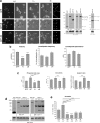Liprin-α1 and ERC1 control cell edge dynamics by promoting focal adhesion turnover
- PMID: 27659488
- PMCID: PMC5034239
- DOI: 10.1038/srep33653
Liprin-α1 and ERC1 control cell edge dynamics by promoting focal adhesion turnover
Abstract
Liprin-α1 and ERC1 are interacting scaffold proteins regulating the motility of normal and tumor cells. They act as part of plasma membrane-associated platforms at the edge of motile cells to promote protrusion by largely unknown mechanisms. Here we identify an amino-terminal region of the liprin-α1 protein (liprin-N) that is sufficient and necessary for the interaction with other liprin-α1 molecules. Similar to liprin-α1 or ERC1 silencing, expression of the liprin-N negatively affects tumor cell motility and extracellular matrix invasion, acting as a dominant negative by interacting with endogenous liprin-α1 and causing the displacement of the endogenous ERC1 protein from the cell edge. Interfering with the localization of ERC1 at the cell edge inhibits the disassembly of focal adhesions, impairing protrusion. Liprin-α1 and ERC1 proteins colocalize with active integrin β1 clusters distinct from those colocalizing with cytoplasmic focal adhesion proteins, and influence the localization of peripheral Rab7-positive endosomes. We propose that liprin-α1 and ERC1 promote protrusion by displacing cytoplasmic adhesion components to favour active integrin internalization into Rab7-positive endosomes.
Figures








References
-
- de Curtis I. & Meldolesi J. Cell surface dynamics - how Rho GTPases orchestrate the interplay between the plasma membrane and the cortical cytoskeleton. J. Cell Sci. 125, 4435–4444 (2012). - PubMed
-
- Astro V., Asperti C., Cangi M. G., Doglioni C. & de Curtis I. Liprin-α1 regulates breast cancer cell invasion by affecting cell motility, invadopodia and extracellular matrix degradation. Oncogene 30, 1841–1849 (2011). - PubMed
-
- Chiaretti S. & de Curtis I. Role of Liprins in the Regulation of Tumor Cell Motility and Invasion. Curr. Cancer Drug Targets 16, 238–248 (2016). - PubMed
-
- Wei Z. et al.. Liprin-mediated large signaling complex organization revealed by the liprin-α/CASK and liprin-α/liprin-β complex structures. Mol. Cell 43, 586–598 (2011). - PubMed
LinkOut - more resources
Full Text Sources
Other Literature Sources

